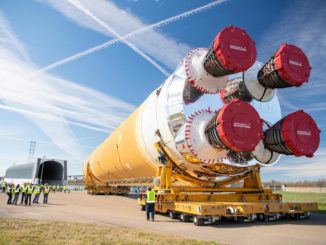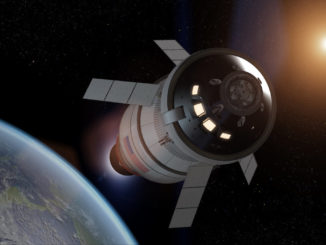EDITOR’S NOTE: Updated at 11 p.m. EDT (0300 GMT) with Modi comments.

Ground teams lost communication with India’s first lunar landing mission moments before its scheduled touchdown on the moon Friday, and the robotic research craft apparently crashed during final descent.
The Indian Space Research Organization, or ISRO, said controllers lost contact with the Vikram lander in the final minutes of its descent to a landing site near the moon’s south pole.
A live broadcast from the lander control center in Bengaluru showed tension rising as the spacecraft neared the lunar surface, with excitement turning to despondency after engineers unexpectedly lost their radio link with Vikram.
India was seeking to become the fourth country to achieve a soft landing on the moon, following successes by the former Soviet Union, the United States and China.
The Vikram lander, part of India’s multi-part Chandrayaan 2 mission, was steering toward a landing zone at 70.9 degrees south latitude on the near side of the moon. Touchdown was set for 4:23 p.m. EDT (2023 GMT) Friday.
The spacecraft’s targeted landing site was closer to the moon’s south pole than any previous mission.
Indian prime minister Narendra Modi observed the landing attempt from a gallery overlooking the Chandrayaan 2 control center in Bengaluru.
Video from the live broadcast showed K. Sivan, ISRO’s chairman, meeting with Modi soon after teams lost contact with Vikram, apparently briefing the prime minister on the status of the landing attempt.
Somber scenes inside India’s Chandrayaan 2 control center after teams lost communication with the Vikram moon lander. https://t.co/QL0rCdshIS pic.twitter.com/kjVBb7e3Mb
— Spaceflight Now (@SpaceflightNow) September 6, 2019
Vikram, named for the father of India’s space program, was in the final stages of a 15-minute powered descent to the moon’s surface when teams lost contact with the spacecraft.
“The Vikram lander descent was as planned, and normal performance was observed up to an altitude of 2.1 kilometers (1.3 miles),” Sivan said in the control center after briefing Modi. “Subsequently, the communications from the lander to the ground station was lost. The data is being analyzed.”
Modi later visited ISRO teams, telling them to “be courageous” before meeting with Indian students invited to witness the landing at the control center.
The somber mood inside the Chandrayaan 2 control center mirrored the appearance of Israeli engineers in April, when the Beresheet lander crashed during an attempt to become the first privately-funded spacecraft to safely land on the moon.
The Indian prime minister returned to the control center Bengaluru several hours later to address the nation.
“We came very close, but we will need to cover more ground in the times to come,” Modi said. “Every Indian is filled with a spirit of pride as well as confidence. We are proud of our space program and scientists. Their hard work and determination has ensured a better life, not only for our citizens, but also for other nations … India is suffering, but there will be many more opportunities to be proud and rejoice.
“When it comes to our space program, the best is yet to come,” Modi continued. “There are new frontiers to discover and new places to go … To our scientists, I want to say India is with you.”
India’s landing attempt Friday was the third try to put a spacecraft on the moon’s surface this year. Before Beresheet’s failed landing in April, China successfully landed the Chang’e 4 spacecraft on the far side of the moon in January.
The Vikram lander ignited four of its retrorockets as designed at 4:07 p.m. EDT (2007 GMT) to begin a pre-programmed descent sequence expected to last more than 15 minutes. The braking rockets were designed to slow Vikram’s horizontal velocity from 3,600 mph (1.6 kilometers per second) to zero in preparation for landing.

The four throttleable liquid-fueled engines fired for 11 minutes, apparently as designed, to complete the Vikram lander’s “rough braking phase” guiding the craft to an altitude of around 24,000 feet, or 7.4 kilometers. Then Vikram was supposed to use a laser altimeter and hazard avoidance camera to scan the lunar surface, providing inputs to the spacecraft’s navigation computer to control its descent rate.
Vikram was then supposed to head for an altitude of around 1,300 feet (400 meters), before proceeding down to 330 feet (100 meters). The four-legged spacecraft was programmed to hover momentarily to allow its landing sensors to identify a safe, flat, boulder-free landing site before beginning the final descent.
A center engine was scheduled to ignite at an altitude of approximately 42 feet (13 meters) to control the final seconds of the landing, a measure intended to reduce the amount of dust kicked up as Vikram reached the lunar surface.
But the loss of communication suggested something went wrong during the final minutes of Vikram’s descent. ISRO did not offer any additional details on the fate of the lander in the immediate hours after the preset landing time.
Less than half of the attempts to land on the moon since the dawn of the Space Age have been successful.
In a press conference before Vikram’s descent, Sivan said he was confident in a smooth landing.
“One good thing is we are learning from their failures,” he said.
“We have the confidence in this landing mission,” Sivan said before the landing attempt. “We are confident because we have enough testing, enough simulations. All the subsystem- and system-level, sensor-level, thruster-level, all the simulations here are done. We are confident that anything humanly possible, we did.
“But at the same time, it’s a new mission,” he said. “It’s a terrifiying moment for us.”

The Chandrayaan 2 mission launched July 22 from a spaceport on India’s southeastern coast, and it arrived in orbit around the moon Aug. 20. The Chandrayaan 2 mission’s orbiter module, which will image and study the moon from an altitude of around 62 miles (100 kilometers), separated from the mission’s Vikram lander Monday at 0745 GMT (3:45 a.m. EDT).
The Vikram lander then fired its rocket thrusters to maneuver into a lower orbit that ranges between 21 miles (35 kilometers) and 62 miles (101 kilometers) above the moon’s surface.
The maneuvers set up Vikram to begin its final 15-minute powered descent Friday.
“From that time onward, the entire thing will be decided by the Chandrayaan 2 lander only,” Sivan said before the landing attempt. “When the lander is coming down, it will take images of the place, and it will compare with the image of what we stored on-board. It will find a flat surface, it will re-target, it will hover for some time, and it will decide where to land, and it will land. It will land autonomously in an intelligent way.”
The lander measured about 8.3 feet (2.5 meters) tall and 6.6 feet (2 meters) wide, and it carried a 59-pound (27-kilogram) rover named Pragyan, the Sanskrit word for “wisdom.”
The Pragyan rover was expected to drive off a ramp onto the lunar surface a few hours after Vikram’s landing. Pragyan was designed to study the composition of rocks and soil at the landing site, while Vikram was to take panoramic images and conduct its own experiments.
“We have payload systems on the orbiter, and some are on the lander, and some are on the rover,” Sivan said. “Mainly these will be looking at rock-forming elements … mapping of rock-forming elements like magnesium, aluminum, calcium, iron. That is one study.
“Another one is the mapping of minerals and water,” he said. “Then another scientific study is the study of the exosphere. The atmosphere is very, very mild. Then, at the place where the lander is landing, what is the seismic activity there? Another thing is after landing, a probe will go into the lunar surface and study the thermal characteristics and thermal conductivity.”
A NASA-provided laser retroreflector was also aboard the Vikram lander.
Although the landing attempt apparently ended in failure, Chandrayaan 2’s orbiter remains healthy and is just starting its one-year science mission.
The orbiter carries eight scientific instruments, including a high-resolution stereo imaging camera, a dual-frequency synthetic aperture radar look for evidence of water ice at the lunar poles, an imaging infrared spectrometer to aid in the search for water, and sensors to study the moon’s tenuous atmosphere.
The orbiter was also to provide data relay services the Vikram lander.
Developed at a cost of around $140 million, the Chandrayaan 2 mission is the most ambitious in the history of India’s space program. It follows Chandrayaan 1, a lunar orbiter launched in 2008 that detected the first evidence of water ice hidden inside permanently-shadowed craters at the lunar poles.
India has also placed a spacecraft in orbit around Mars, and the country’s Polar Satellite Launch Vehicle is a workhorse for launching Indian Earth-observing missions and numerous commercial CubeSats and microsatellites from international customers.
Most of ISRO’s programs focus on environmental observation, weather forecasting and communications, services that aid the country’s population of more than 1.3 billion people.
But ISRO has expanded its portfolio over the last decade, with lunar and Mars missions, a quickening pace of rocket launches, and plans for a space capsule to carry Indian astronauts into orbit.
Email the author.
Follow Stephen Clark on Twitter: @StephenClark1.



